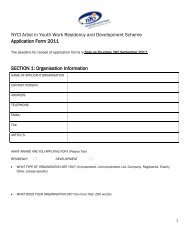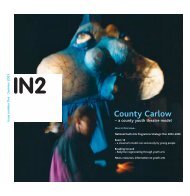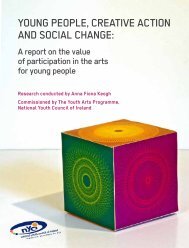DRAMA SPACES - Youth Arts Programme
DRAMA SPACES - Youth Arts Programme
DRAMA SPACES - Youth Arts Programme
Create successful ePaper yourself
Turn your PDF publications into a flip-book with our unique Google optimized e-Paper software.
dramaspaces6 18/8/05 4:25 PM Page 59Appendix 2: Glossary of TermsBlockingThis is where one person stops an improvisation or stopsthe flow of creativity and is unacceptable in these situations.It is your role to ensure that this doesn’t happen.(The) BookThis is a copy of the script where the actors’actions,lighting and sound cues and set changes are recorded.DevisingThis is where a group creates a piece for performancethrough drama workshops.De-RolingTo assist an individual when they are no longer requiredto play a role in a drama workshop.DistancingCreating a clear distinction between the person andtheir role or character they are playingDrama in EducationA range of techniques designed to assist formal educationallearning through engagement in drama.Get-InThis is when the set and other equipment,e.g. lights are installed in the venue.HookThis is something that will hook your group’s imaginationor interest and through which you can explore the issueHot-seatingOthers question an actor while he or she is in role.The actor has to answer as his or her character would.Be aware that it is clear that this is not done to ‘catchout’the actor on his or her knowledge of a character butit is to enrich that knowledge. Be aware also that this isa very high-focus exercise for the person being hot-seated.As facilitator, you will need to watch them for stressand fatigue.In RoleWhen an individual plays through a situation ‘as if’he orshe is a character they created in a drama workshop.Leader in RoleThis is where the leader takes on a role within a drama.Process DramaThis is used a lot in Drama in Education. It differs fromrole-play in that the participants are enabled to live througha drama experience ‘as if’they are the characters thatthey create.RoleA character created by an individual in a drama workshop.Role-playThere are two types of role-play:• One is a form of simulation, where the leader willgive the participants roles to play through, e.g. youare the mother and you are the child.• The other is role work where participants developroles and situations in an exploratory way.These characters develop depth over time.Role on the WallThis is a therapeutic tool that was adapted for dramause by Jonathan Neelands. Information is written insideand outside an outline of a person drawn on a large pieceof paper.The information sought for the outside of theoutline has to differ from that on the inside. It is thecontrast and commonalties in the different informationthat is being soughtShadow RoleWhen the entire group are placed into a group role –e.g. you are all stall-holders in the market square of OldVerona.Side coachingThis is a technique where you go around the groups andoffer help and advice to keep them focused on the taskin hand. Using this, you can help the group think of themotivations driving the characters or the emotionalthread running through the story.The trick is not to beintrusive.Thought TrackingQuestioning a player about how their character isfeeling when they are in a frozen image.IsolationsUsing a series of general physical exercises you isolate,or create an awareness of different sections of the body.59






